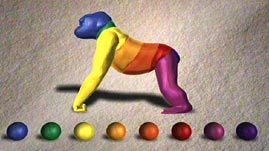As far back as the 19th century it was apparent to some biologists that a simple, repeated pattern underlay the differing body structures of animals. It could be seen in the segmented bodies of worms, in the vertebrae of animals with backbones, in the head-thorax-abdomen construction of insects. In all of these, modular units like Lego(TM) blocks were arranged in a front-to-back line down the center of the body.
Yet it was a complete mystery how the blueprints in the developing embryo of these creatures guided the assembly of these complex parts. Only in the past two decades has the answer begun to emerge. The development of body plans in all animals is controlled by a remarkably small number of genes -- and those genes are virtually identical in all animals. Clues came from instances in which the pattern is marred by mutations in these crucial genes. In fruit flies, for example, a malfunctioning body-plan gene can produce a fly with legs sprouting from where the antennae should be on the head. Or the fly has an extra set of wings -- or no wings at all.
The genes containing developmental instructions for the body plan are known as homeobox-containing genes. The DNA code in homeobox genes directs the cell to make chemical sequences, which in turn regulate still other genes that affect the positioning of cells in the embryo. While this sounds complicated, it is a far more elegant and simple mechanism than scientists thought could possibly be responsible for the enormous variation we see when we survey the animal kingdom.


 Loading Standards
Loading Standards Teachers' Domain is proud to be a Pathways portal to the National Science Digital Library.
Teachers' Domain is proud to be a Pathways portal to the National Science Digital Library.
